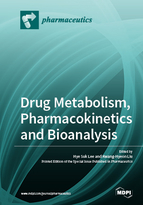Drug Metabolism, Pharmacokinetics and Bioanalysis
A special issue of Pharmaceutics (ISSN 1999-4923).
Deadline for manuscript submissions: closed (15 August 2018) | Viewed by 82717
Special Issue Editors
Interests: bioanalysis; drug metabolism; pharmacokinetics; drug interactions
Special Issues, Collections and Topics in MDPI journals
Interests: drug metabolism; metabolomics; lipidomics
Special Issues, Collections and Topics in MDPI journals
Special Issue Information
Dear Colleagues,
Drug metabolism/pharmacokinetics and drug interaction studies have been extensively carried out in order to secure the druggability and safety of new chemical entities throughout the development of new drugs. Recently, drug metabolism and transport by phase II drug metabolizing enzymes and drug transporters, respectively, as well as phase I drug metabolizing enzymes, have been studied. A combination of biochemical advances in the function and regulation of drug metabolizing enzymes and automated analytical technologies are revolutionizing drug metabolism research. There are also potential drug–drug interactions with co-administered drugs due to inhibition and/or induction of drug metabolic enzymes and drug transporters. In addition, drug interaction studies have been actively performed to develop substrate cocktails that do not interfere with each other and simultaneous analytical method of substrate drugs and their metabolites using a tandem mass spectrometer.
This Special Issue has the aim of highlighting current progress in drug metabolism/pharmacokinetics, drug interactions and bioanalysis.
Prof. Hye Suk LeeProf. Kwang-Hyeon Liu
Guest Editors
Manuscript Submission Information
Manuscripts should be submitted online at www.mdpi.com by registering and logging in to this website. Once you are registered, click here to go to the submission form. Manuscripts can be submitted until the deadline. All submissions that pass pre-check are peer-reviewed. Accepted papers will be published continuously in the journal (as soon as accepted) and will be listed together on the special issue website. Research articles, review articles as well as short communications are invited. For planned papers, a title and short abstract (about 100 words) can be sent to the Editorial Office for announcement on this website.
Submitted manuscripts should not have been published previously, nor be under consideration for publication elsewhere (except conference proceedings papers). All manuscripts are thoroughly refereed through a single-blind peer-review process. A guide for authors and other relevant information for submission of manuscripts is available on the Instructions for Authors page. Pharmaceutics is an international peer-reviewed open access monthly journal published by MDPI.
Please visit the Instructions for Authors page before submitting a manuscript. The Article Processing Charge (APC) for publication in this open access journal is 2900 CHF (Swiss Francs). Submitted papers should be well formatted and use good English. Authors may use MDPI's English editing service prior to publication or during author revisions.
Keywords
- Drug metabolism
- Pharmacokinetics
- Drug transporter
- Drug-drug interaction
- Bioanalytical method
- Mass spectrometry








